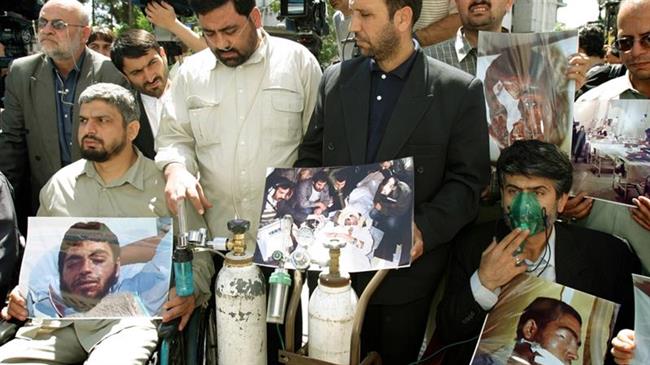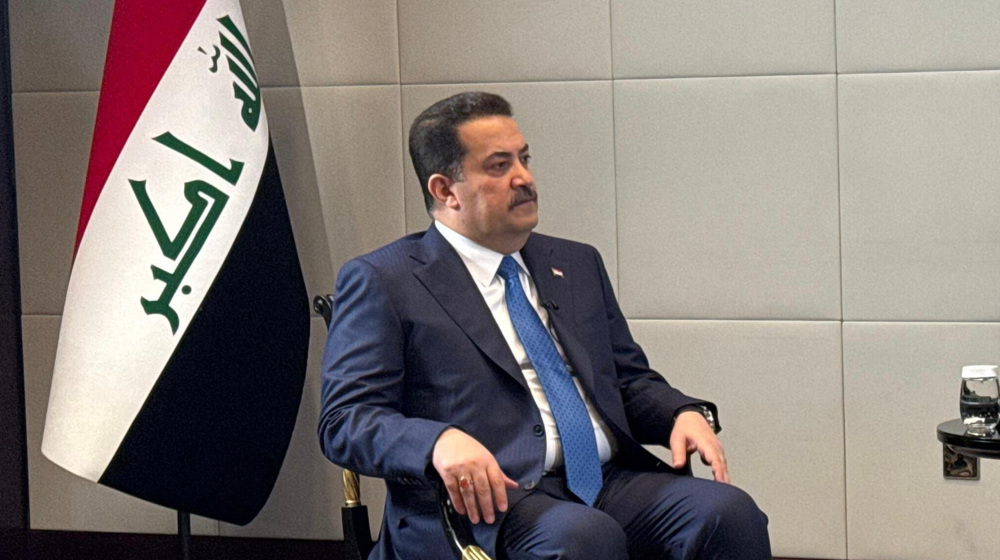US, allies accomplices to Saddam’s chemical attacks on Iran
When former Iraqi dictator Saddam Hussein used chemical weapons to kill thousands of Iranians during the imposed war from 1980 to 1988, not only did the US and its Western and regional allies look the other way but they also aided the then-dictatorial regime in committing war crimes.
Iraq didn’t have the possibility of producing the bombs from scratch. But it had several accomplices. Countries providing Iraq with the ingredients for chemical bombs knew Iraq was at war.
The US, the UK, Germany, Italy, and Holland were among the countries providing Saddam Hussein’s Ba’athist Iraq with the equipment and material to build chemical weapons.
Iraq made the most of its acquisitions by launching over 350 large-scale gas attacks along the Iran-Iraq border between 1980 and 1988 on soldiers and civilians alike.
And it wasn’t just mustard gas. Iraq also used the nerve agents VX, Tabun, and Sarin. This left Iran with over 107,000 victims, 2,600 of whom died at the time. Over 45,000 others were left in permanent need of relief aid provided by Iran’s Veterans and War Victims Foundation.
The northwestern Iranian town of Sardasht was just one of the civilian areas to experience the devastating effects of mustard gas and nerve agents.
The citizens of Sardasht were all too accustomed to Iraqi bombardment in the 1980s — conventional bombs that is. Little did they know that the new chemical bombs didn’t have to explode to kill and maim. Before they knew it, 110 people were dead.
It was on July 22, 1988 when Zardeh, a village of 1,700 residents were hit presumably by Tabun, a nerve gas that causes convulsions and paralysis before death. This killed 275 on the spot and injured 1,146. Not least, a Zardeh water source was contaminated by missile collision. This poisoned people and animals in other villages.
Other Iraqi dirty strikes on Iran after Sardasht were carried out in March 1988 in villages around the city of Marivan, and in May-June 1988 in villages around the cities of Sarpol-e Zahab, Gilan-e-gharb, and Oshnavieh.
In March 1988, Iraq also used chemical weapons in Halabja, home to Iraqi Kurds, who had joined with Iran in fighting Saddam. According to reports, 5,000 mainly women and children were killed of mustard gas and sarin poisoning, and up to 12,000 have died since because of chemical exposure.
Today, Tehran’s Peace Museum is a reminder of the horrors of chemical warfare
The Iranian nation revisited the Sardasht affair on its 32nd anniversary recently. That is barely over a month apart from Hiroshima and Nagasaki days on August 6 and 9, when the Japanese cities were nuked by the US in 1945.
Iranian Foreign Minister Mohammad Javad Zarif in a message paid tribute in to Sardasht chemical attack victims.
“Undoubtedly, the chemical bombardment of Sardasht is one of the most bitter memories remained for the Iranians since the eight years of the imposed war…,” Zarif said. “This stain of disgrace will remain on the foreheads of the perpetrators and supporters of this crime forever.”
“The Islamic Republic of Iran, in accordance with the legal, religious and ethical norms on the prohibition of Weapons of Mass Destruction, insists on its principled policy of condemning the use of chemical weapons at any time, any place and under any circumstances, and considers the complete elimination of the remaining stockpiles of chemical weapons of the US, the only holder of those weapons…, as a key step towards achieving a world free of WMDs,” the top Iranian diplomat stated.
Today, Iran is the world’s largest laboratory for the study of the effects of chemical weapons, because of the unthinkable number of Iranian victims.
While small-pox has been eradicated more or less, and cancer patients get to live a decade longer in comfort, victims of chemical warfare say they only feel worse as time goes by.
Mustard gas or sulfur mustard initially smells as harmless as garlic. But it can cause large blisters on the skin and in the lungs. Its victims suffer anything from blindness to cancer. The nerve agent was used against Iran in dusty, liquid, and vapor forms.
The ongoing suffering of lives impaired is undeniable. But, as Dr. Mostafa Ghanei, pulmonary specialist, makes the point, it could have been even worse.
“Only God knows what would happen to the poor victims of chemical attacks if it wasn’t for Iran’s findings in this field. Iran’s findings helped reduce the symptoms of the victims of Halabja chemical attack down to 50 percent,” he told Press TV
Shahram Shoeibi, an expert from Food and Drug Organization, said, “Nuclear bombs have a massive destructive power; they can kill a huge number of people in a few seconds and destroy cities and infrastructure completely. Chemical weapons do not have such power but they can destroy the internal organs of a body. We can refer to chemical bombs as the nuclear bombs of human bodies because they did to a human body what nuclear bombs do to a city.”
About a million Iranians in different regions were exposed to Iraq’s chemical gases. While it seems insulting to compare those Iranian cities’ catastrophic plight to any other, a certain Japanese lady insists the world should annually commemorate and commiserate chemical warfare victims also, on Sardasht Day. Married to an Iranian, she gave up a son to the 8-year war imposed on Iran.
“During the war, together with other Iranian women who were caring for the injured, guarding ammunition depots, and organizing food drives, I did my best to help as much as I can. I had learnt that for independence, we must make sacrifice otherwise world powers will plunder your resources.” Haniko Yamamora, a mother of chemical attack victim, said.
Ahmad Saleemi, an Iran-Iraq war veteran who was injured on the border between Iran and Halabja, said the victims of the chemical attacks were fighting in a second war caused by the shortage of drugs.
“Unfortunately, we don’t have access or at least easy access to the medicines that relieve our pain.”
Other chemical victims Press TV spoke to were Ali Akbar Fazli and Morad Darvishi.
“Chemical agents affect lungs and internal organs of the body badly. Victims of chemical weapons like me cannot tolerate pungent smell; if there is pungent smell, I can’t even talk anymore,” said another war veteran Fazli, adding, “My left hand and leg have been injured during the war I also suffer a ruptured eardrum because of a mortar explosion,” Darvishi.
“It was the Operation Dawn 8 in Arvand Rud; I was doing my job as a nurse in the warzone that the chemical weapons bombardment of Iraqis started. It was nerve agent,” said Darvishi.
“I was actually wearing protective suit and gas mask but it wasn’t enough. Due to the explosions my eardrums were ruptured. After I went into a coma, they took me to a hospital in Tehran. For three months, I could not hear or see a thing. My skin was entirely peeled off from top to toe. I got blisters all over,” he added.
Ahmad Momeni Rad, at faculty of law and political science of the University of Tehran said that the United Nations Security Council had asked the inspectors of the UN and IAEA to keep secret the identity of the companies which had sold chemical weapons to Iraq.
“In 2004, a trial was held against a man named Frans van Anraat in Netherland who was the head of one of the companies which sold thousands of tons of raw materials of chemical weapons to Saddam. He was arrested and sentenced to prison time under the conviction of complicity in genocide but the UNSC did almost nothing but a mere expression of regret. This is while the UNSC was expected to pass a tough resolution against the Iraqi Baath Regime.”
It was notable not only that “there was no outrage” from the US and its allies when the chemical attacks took place in Iran, but the US also used its influence in the UN Security Council to block any condemnation of Saddam.
Hamas thanks Iran, Resistance Front following achievement of ceasefire in Gaza
'Capitulation': Israeli officials and media concede Gaza defeat as truce unfolds
'Gaza has won': Social media users react to ceasefire with mix of relief, joy
Iran seeks South Korea’s assistance for AI, fiber-optic projects
VIDEO | Iran's 'Eqtedar' (Power) maneuver
Israel hits HTS military target in Syria for 1st time since fall of Assad
VIDEO | Press TV's news headlines
Israel has slaughtered 13,000 students in Gaza, West Bank













 This makes it easy to access the Press TV website
This makes it easy to access the Press TV website